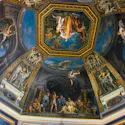The Vatican Museums are a collection of art museums located within Vatican City. They are known for their extensive collection of artworks and historical artifacts that span centuries of history. The museums are home to some of the most renowned masterpieces in the world, including Michelangelo's Sistine Chapel ceiling and Raphael's School of Athens. From ancient Egyptian artifacts to Renaissance sculptures, there is something to captivate every art enthusiast. Make a checklist of what you should not forget to see or do on your visit with the help of this guide.
Vatican Museum Information
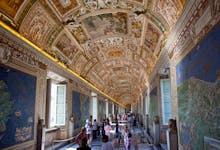
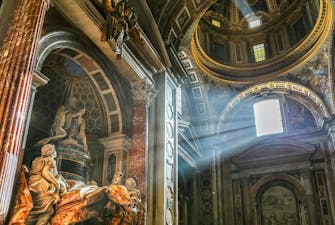
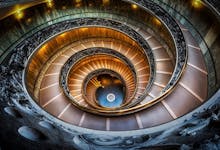
Vatican Museums - Things to know
| ⏰ Suggested duration: | 2.5 hours |
| ☀️ Best Time to Visit: | Early morning or early afternoon |
| 🎟️ Vatican Museum ticket: | €14.5 |
| 🚇 Closest Train Station: | Ottaviano-S. Pietro - Line A |
Opening Hours
• Monday - Saturday: 09:00 AM to 06:00 PM (Ticket office closes at 04:00 PM)
• Sunday - Closed
• Last Sunday of each month: 09:00 AM to 02:00 PM. (Ticket office closes at midday, 12:30 PM)
Must-see
The Spiral Staircase
Raphael's Transfiguration
Pinecone Courtyard
Apollo Belvedere
Vatican Museums Address
Viale Vaticano,
00165 Rome, Italy
Get Directions
Recommended Vatican Museums Tickets
A Short History Of The Vatican Museums
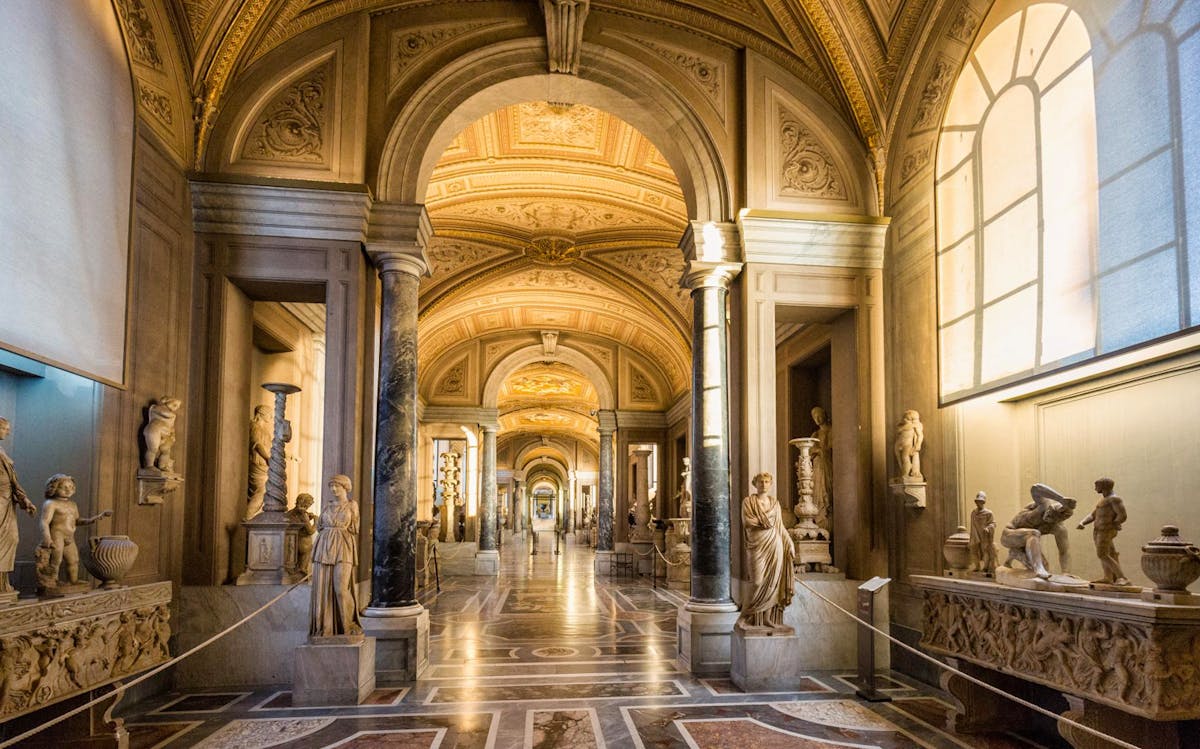
The history of Vatican Museums began with the purchase of the marble sculpture, 'Laocoön and His Sons' in 1506. This discovery led to the establishment of the Vatican Museums by Pope Julius II. Over the years, the collections grew, and in the 18th century, Pope Benedict XIV founded the Museum Christianum and the Lateran Museum.
At its inception, Pope Julius Ⅱ had established a state collection of classical sculptures at the Octagonal Courtyard. Pope Clement XIV and Pope Pius VI ordered the building of the first museum which structured the exhibition of artworks for the public in the later 18th century which is now called the Pius-Clementine Museum. In 2006, the Vatican Museums celebrated their 500th anniversary and opened the excavations of the Vatican Hill necropolis to the public.
The Vatican Museum Architecture & Design

The Vatican Museums are housed in a complex of buildings that showcase various architectural styles, ranging from Renaissance to Baroque. It is home to one of the greatest masterpieces of history - Michelangelo’s fresco at the Sistine Chapel, which also marks the end of the Museum. Another notable feature is the spiral staircase, known as the Bramante Staircase, which was designed by Giuseppe Momo in the 20th century. Its elegant design and graceful curves make it a standout feature of the museums. The Egyptian museum features art pieces from Ancient Egypt mostly brought to Rome during the Roman Empire and encompasses 9 rooms arranged around the so-called hemicycle. Etruscan Museum includes artifacts coming from archaeological sites located in the Etruria, a region comprising modern Tuscany, Lazio, and Umbria.
What To See Inside The Vatican Museums?
The Vatican Museum consists of 54 museums and their collections housed in the Vatican Palaces. The compilation in the museum is art produced in a span of 800 years. Many famous artists of this time including Giotto, Fra Angelico, Perugino, Melozzo da Forlì, Raphael, Leonardo da Vinci, Titian, and Caravaggio have contributed to the museum's collection. Here are the popular galleries in The Vatican that you must visit!
Galleries Inside The Vatican

The Gallery of maps is a 120 metre long gallery in the Vatican Museums that is covered with painted maps of Italy based on drawings by friar and geographer Ignazio Danti. It took Danti 3 years to complete the 40 panels that make up the Gallery of Maps. The gallery showcases the detailed cartographic work and artistic skill of the time.

The Gallery of Tapestries, also known as Galleria Degli Arazzi, is a magnificent collection of tapestries housed in the Vatican. The tapestries on display depict various episodes from the Life of Christ, as well as scenes from the life of Pope Urban VIII. They are known for their exquisite craftsmanship and attention to detail.

The Pio Clementino Museum is a magnificent complex that showcases some of the most important Greek and Roman masterpieces. It owes its name to the two popes, Pope Clement XIV and Pope Pius VI, who played significant roles in its establishment and expansion. The museum consists of twelve rooms that house an impressive collection of classical sculptures and artworks. One of the highlights of the museum is the statue of Laocoön, known for its dramatic depiction of the Trojan priest and his sons being attacked by sea serpents. Another iconic piece is the Apollo of the Belvedere, a marble sculpture depicting the Greek god of music and poetry.

The Gregorian Egyptian Museum, founded in 1839 by Pope Gregory XVI, is a hidden gem located within the Vatican's Belvedere Palace. This extraordinary museum consists of nine rooms, once serving as Pope Pius IV's private apartments. During the Imperial Age, Romans developed a fascination with all things Egyptian. The allure of this ancient civilization led to a trend of importing Egyptian artworks and artifacts to Rome. Its collection includes a wide range of artifacts from ancient Egypt, as well as items from Hadrian's Villa Adriana in Tivoli.

The Raphael Rooms are a series of four rooms originally designed and painted by the renowned Italian artist Raphael and his students.The rooms are named after the main theme of each fresco: the Room of Constantine, the Room of Heliodorus, the Room of the Segnatura, and the Room of the Fire in the Borgo. Each room is adorned with intricate frescoes depicting various biblical and historical scenes. These frescoes are considered to be some of Raphael's greatest masterpieces and are a must-see for art enthusiasts visiting the Vatican.

The Musee Gregorien Profane, located in the Lateran Apostolic Palace, is a captivating museum that showcases a wide array of archaeological finds and artworks from various eras. Founded in 1844 by Pope Gregory XVI Cappellari, the museum offers a glimpse into classical art, spanning from Ancient Greece to the late Imperial Roman age. The museum also houses a collection of sarcophagi, showcasing the intricate craftsmanship and symbolism associated with ancient burial practices.

The Gallery of Contemporary Art in Vatican is a remarkable collection of modern and contemporary artworks. It showcases a diverse range of artistic styles, including surrealism, cubism, post-impressionism, and expressionism. Many of these works were donated by renowned artists and collectors to the Holy See.

Commissioned by Pope Pius VI Braschi and later renovated during the pontificate of Pope Leo XIII Pecci, this gallery is a testament to the artistry and grandeur of its time. The gallery is divided into six sections by colored marble columns, adding to its visual splendor. The walls and vaults are adorned with chiaroscuro and grisaille frescoes, showcasing the mastery of these traditional techniques

The Pinacoteca is a hidden gem nestled within the Vatican Museums. This exquisite gallery, designed by the talented architect Luca Beltrami, was commissioned by Pius X in the 1932. With its eighteen rooms showcasing the rich tapestry of Italian painting, the Pinacoteca houses a remarkable collection of 460 paintings. The initial foundation of this collection can be traced back to Pope Pius VI, who had amassed a collection of 118 paintings.

Christian Lapidarium in Vatican is a collection of Christian inscriptions and ancient artifacts. It houses a vast array of sculptures, sarcophagi, and other relics dating back to the early Christian era. In addition to Christian Lapidarium The Vatican also houses The Jewish Lapidarium which is a collection of around two hundred inscriptions that were found in the Jewish catacomb of Monteverde.
Essential Information
Vatican Museum Opening Hours
Timings:
- Monday to Saturday - 9 AM to 6 PM
- Final entry is at 4 PM
- Guests are expected to exit the museums by 5.30 PM
- Free entry on every last Sunday of the month, from 9 AM to 2 PM, last entry at 12. 30. Exception to this is if the last Sunday coincides with Easter Sunday, 29 June Sts. Peter & Paul, Christmas Day, Feast of Stephen and Feast of Sylvester.
Vatican Museum Gift Shop
There is an official Vatican Museum Gift Shop just outside the entrance. They have a collection of posters, DVDs, sculptures. Books, accessories, and home decor that you can gift and send a post if you wish.
Getting There
Metro
The Rome Metro has a station just outside the Vatican walls at Ottaviano-S. Pietro. Line A direction Battistini, Ottaviano or Cipro stations of the Metro has trains running every few minutes. It's a 5 minute walk from the Metro to both St Peter's Square and the Vatican Museums.
Bus
49, stop in the square in front of the Vatican Museums
32, 81, 982, stop at Piazza del Risorgimento
492, 990, stop in Via Leone IV / Via degli Scipioni
Insider Tips
- St Peter’s Basilica is free to visit, the Vatican Museum and Sistine Chapel are not. Make sure to purchase a ticket in advance.
- The Spiral Staircase is only open to special tours, so make sure it is highlighted on your ticket if you wish to go there.
- It takes about 3 hours to explore the Vatican Museum. Wear comfortable footwear during your visit.
- The Vatican does have a dress code. For entry into the Vatican, shoulders, and knees must be covered for both men, women, and children.
- Photography is strictly prohibited inside the Sistine Chapel.
- Avoid visiting the Vatican Museums during the peak seasons and keep the opening hours in mind while booking your visit.
- The Vatican Museums has 1400 rooms of art and unfortunately, you can’t see them all in a day. Hence, research the rooms and collections you want to see and visit accordingly.
10 Vatican Museum Facts You Probably Didn’t Know!
- Want to see all of the Vatican Museums’ collects? If you spend a minute looking at each painting in the Vatican museums, it would take you 4 years to see them all completely.
- The museum contains the largest collection of art in the world with 9 miles of pieces, which could wrap four and half times around the Vatican walls.
- The Vatican does not have taxable revenues and generates 90 percent of its revenues from Vatican Museum (admission fees, shops, and donations from devotees all around the world).
- Not only Vatican Museums but a whole Vatican city has been declared a UNESCO World Heritage Site since 1984.
- Vatican City is worth between $10 and $15 billion, making it one of the richest, tax-exempt organizations in the world.
- The Pope does not get paid. Pope Francis has taken a vow of poverty.
- Ever noticed the Pope wearing red shoes and wondered why? The color red has been chosen to represent the blood of Catholic martyrs. The red shoes are a symbol of the submission of the Pope to the ultimate authority of Jesus Christ.
Vatican Museums FAQs
Where is the Vatican Museum located?
When was the Vatican Museum built?
What are the Sistine chapel mass timings?
What days is the Vatican closed?
Are there any free days to enter the Vatican Museum?
What day is the Vatican Museum closed?
What can you not miss at the Vatican Museum?
What famous paintings are in the Vatican Museum?
Where is the spiral staircase in the Vatican Museum?
Did Leonardo Da Vinci paint in the Vatican?
Do I need my passport to visit the Vatican?
How much does it cost to get into the Vatican Museums?
Can you do the Colosseum and Vatican in one day?
Other top Experiences in Rome
While the Vatican Museums are a must-see in Italy, here are some other attractions that are now open to the public that cannot be missed! Check out more Rome attractions.


